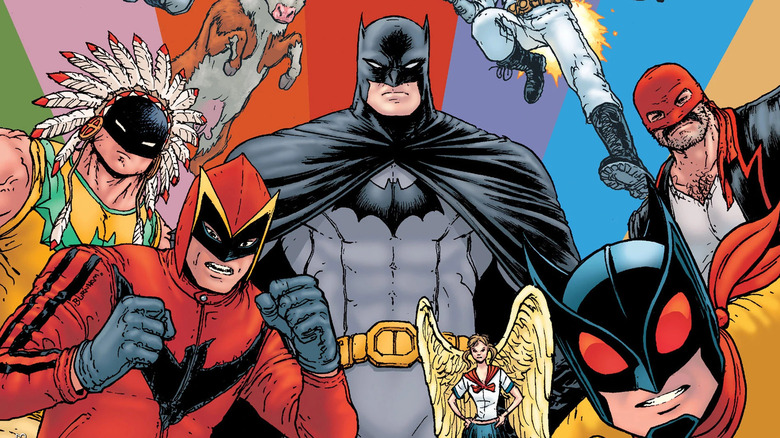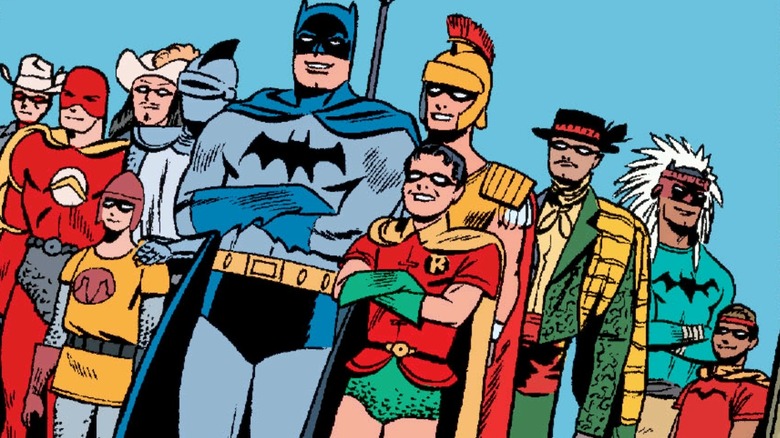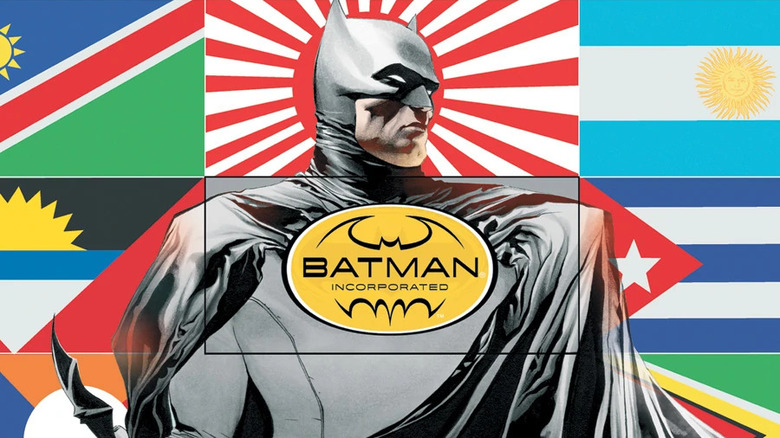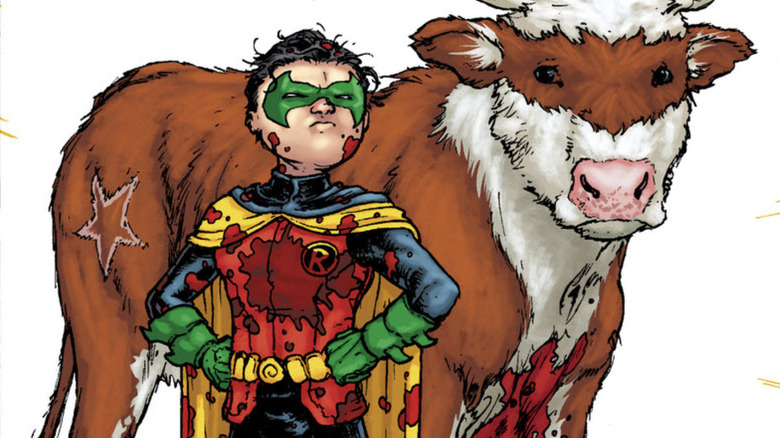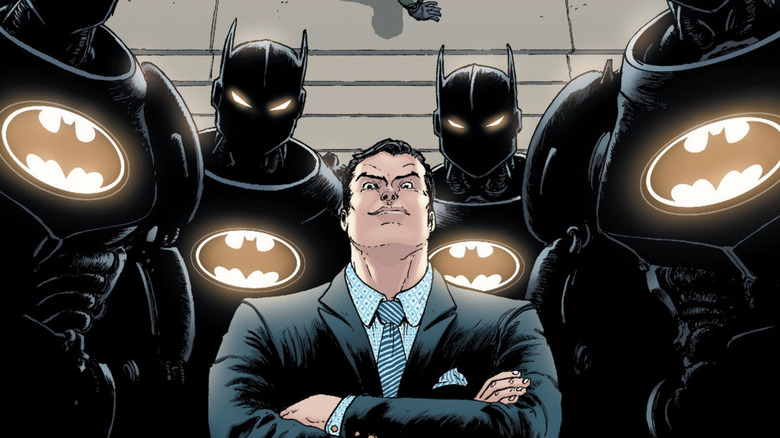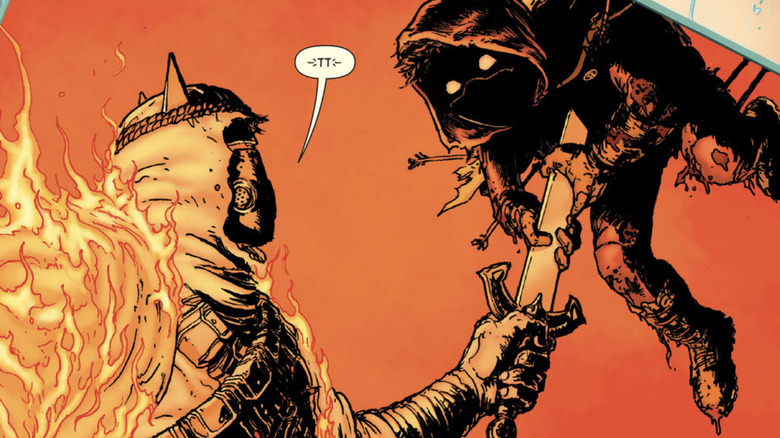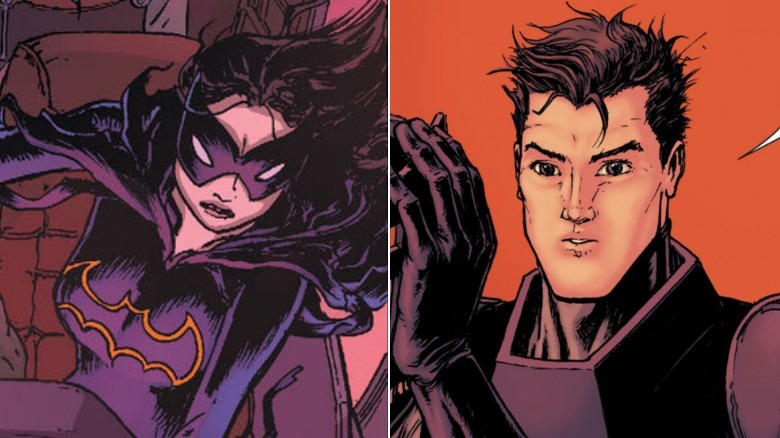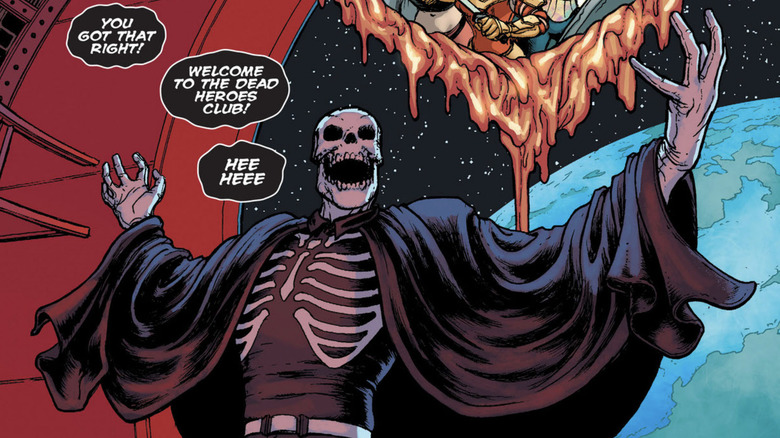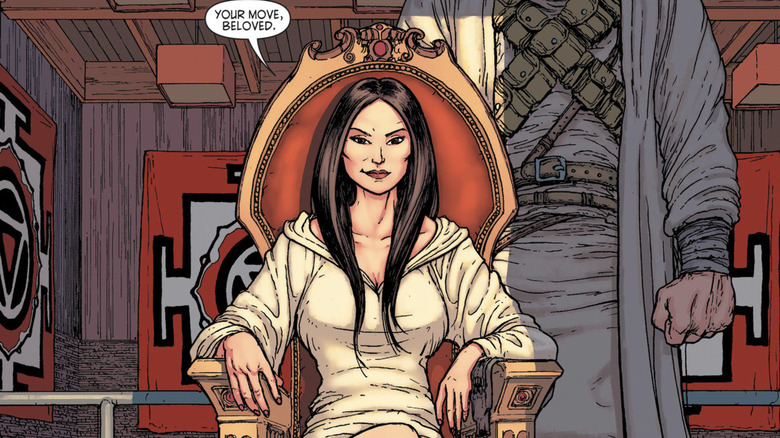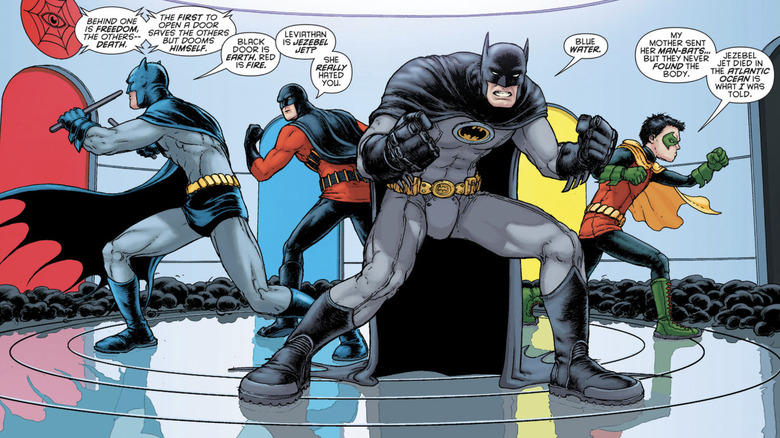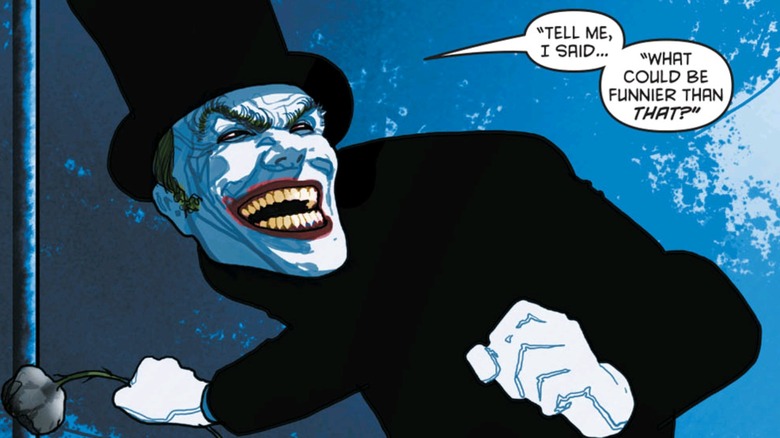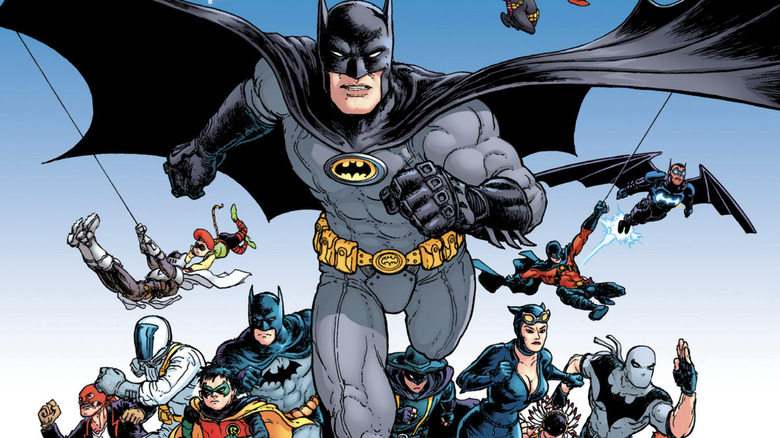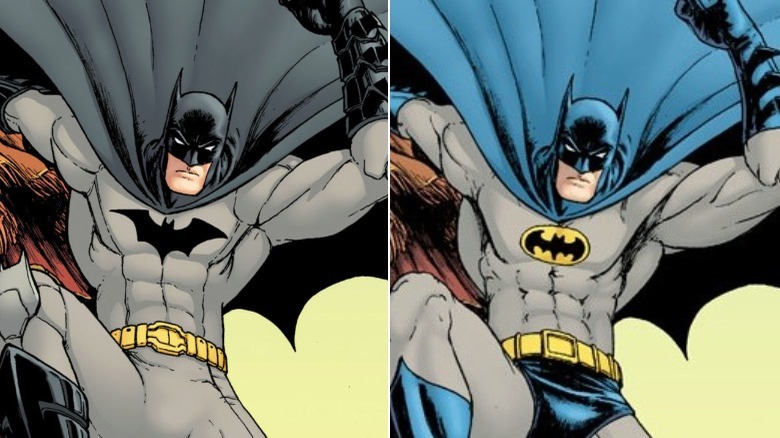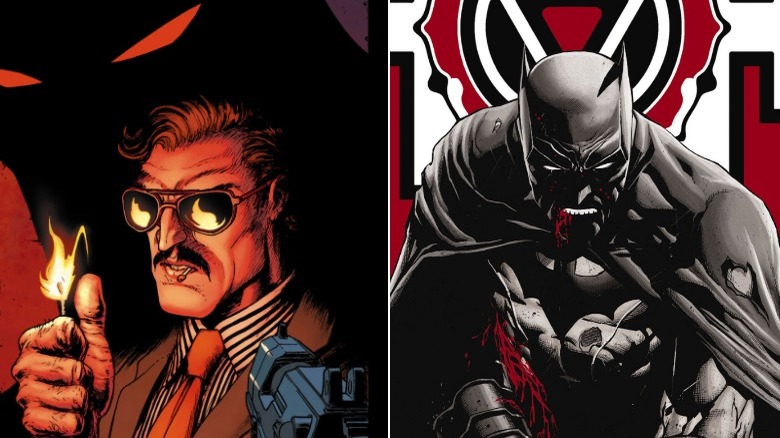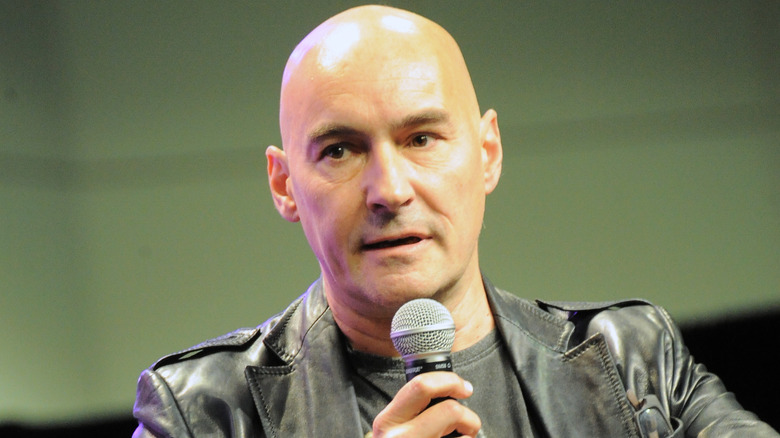14 Bat-Facts Fans Should Know About Grant Morrison's Batman Incorporated
In 2010, Batman's war on crime finally found its army. "Batman Incorporated," written by famed comics and television scribe Grant Morrison, sees the Dark Knight gather a legion of crimefighters to take on the similarly gargantuan forces of Leviathan, an organization bent on infiltrating every major institution — governmental, legal, educational — you can think of. Spanning two volumes, 21 issues, and two specials (only one of which wasn't written by Morrison), the comic book series not only focuses on Batman's war against Leviathan, but also the different ways Batman Inc. members choose to follow their founder's example. At its heart, though, "Batman Inc." is really about the battle between Batman and Leviathan's mysterious leader over the fate of Damian Wayne, Batman's biological son and the Robin of the series.
Though Morrison's "Batman Incorporated" concluded in 2013, it's left an indelible mark on the Bat-mythos. So much so, in fact, that a new "Batman Incorporated" series was launched in 2022 by writer Ed Brisson and artist John Timms. With key player Damian Wayne set to make his live action debut in James Gunn and Peter Safran's DC Universe with "The Brave and the Bold," now seems like the perfect time to shine the Bat Signal once more on one of Damian's — not to mention Batman's — biggest stories to date. Be warned, Bat-fans — there are serious spoilers ahead.
The time-spanning origins of Morrison's Batman
The seeds for Grant Morrison's "Batman Incorporated" are sewn in 2007's "Batman" #667-669 by Morrison and J. H. Williams III, when Batman and several ex-members of the Club of Heroes — an assortment of vigilantes similar to or inspired by Batman — are invited to the island of John Mayhew, their former financial backer from way back in 1957's "World's Finest Comics" #89 by Edmond Hamilton and Dick Sprang. There they learn they've been tricked by Mayhew — who lured him to the island by faking his own murder — and fellow Club of Heroes member Wingman. Although several heroes are murdered, Batman and the other survivors thwart Mayhew and Wingman, though the two still manage to escape. The Club of Heroes later reunites in "Batman" #681 by Morrison and Tony Daniel, having been contacted by Robin two issues earlier to help the Bat-Family battle the Club of Villains.
The Club of Heroes is very much a precursor to Batman Inc. What directly convinces Batman to start a gigantic corporation of crimefighters, however, is his battle through time in Morrison's "Batman: The Return of Bruce Wayne" miniseries. There, after Batman defeats Darkseid's Hyper-Adapter monster with the help of both several modern-day superheroes and the friends he's made while time traveling, does the Dark Knight finally realize that he's never been the loner he's professed to be. From that epiphany, Batman Inc. is born.
Batman Inc. has a worldwide reach
Seeing as the international Club of Heroes is the basis of the Batman Incorporated organization, it probably comes as little surprise that Bruce Wayne would expand its breadth across the globe. As a result, Batman Incorporated boasts members from many nations. Some of the more prominent international members include French crimefighter and parkour expert Nightrunner; English heroes Knight, Squire and the Hood; the original Batwing (David Zavimbi) of the fictional African nation Mtamba; and many others.
Naturally, of course, there are plenty of members hailing from the U.S. of A., Batman's central country of operations. There's Man-of-Bats and Little Raven, who are the Dynamic Duo of their Native American reservation in South Dakota, and of course, Batman's many former sidekicks who fans know and love. Even Batman's old team the Outsiders and Commissioner Gordon are members, although the latter soon finds his ties to Batman Inc. jeopardized by Leviathan's machinations.
Even animals can join
Like most superteams in the DC Universe, the members of Batman Incorporated are primarily human or humanoid. However, the organization has been known to add pets to its crimefighting roster. They follow in the footsteps of perhaps the most famous DC super-pet, Ace the Bat-Hound, a canny canine who not only helps Batman and his allies solve crimes in the Silver Age, but wears his own mask while doing it.
While mask-wearing pets became a thing of the past by the Batman comics of the mid-'60s, Grant Morrison had no problem bringing back such concepts in their Batman stories. While Ace isn't seen in the present day, Morrison cleverly homages the character by having Damian Wayne rescue a cow from a meat-packing warehouse infiltrated by Leviathan. Damian bestows his new four-legged friend the moniker "Bat-Cow" — fitting, as the brown fur around her eyes and ears resembles a bat — and Damian's new pet becomes the young Robin's loyal and loving companion. While Bat-Cow doesn't have the same active crimefighting lifestyle as Ace, the "Bat-Bovine" does stop a pair of criminals who've kidnapped a baby in "Batman Incorporated Special" #1. The story even further pays tribute to the age of Bat-Pets by giving Bat-Cow her own very own scalloped Bat-Cape.
Bruce Wayne joins the fight
Batman has typically kept his civilian life as Bruce Wayne and his superhero adventures separate from one another. Often times, the Dark Knight has even treated his unmasked persona as something of a "disguise," staving off any suspicion that he's Batman by making the world think Bruce Wayne cares too much about the fun life to ever possibly consider the life of a superhero.
Yet Batman decides to make a profound change in how he operates as Bruce after the "Batman: The Return of Bruce Wayne" mini-series. Resurfacing after what the world believed to be simply a prolonged absence, Wayne reveals in a press conference in that he's Batman's financier and intends to help the Dark Knight expand his operations well beyond Gotham. Thus Bruce becomes the very public face of Batman Incorporated, even openly attending events flanked by Ro-Bats, mechanized bodyguards created with the help of Bruce's longtime friend, Lucius Fox.
It nearly ends Damian Wayne's story
Damian Wayne is practically synonymous with Grant Morrison's run on the Batman books. He debuted in Morrison's first story for the "Batman" ongoing series, "Batman and Son," and causes quite a stir with his cavalier attitude toward killing, less-than-mature attitude, and claims that he's Batman's biological child. In Morrison's later Batman stories, however, Damian grows up somewhat, even becoming Robin to Dick Grayson's Batman when Bruce is presumed murdered by Darkseid. Upon returning, however, Bruce eventually forbids Damian from being Robin, as a vision he witnesses suggests Gotham City will one day be atomized thanks to a deal Damian makes with the duplicitous Doctor Hurt for Gotham's safety.
Following orders has never been Damian's specialty, however, and the young Robin dons his costume one last time to break into Wayne Tower, which Talia has seized, and try to reason with his mom. Instead of finding Talia, however, he instead contends with his genetically engineered "brother," also named Leviathan, and several League of Assassin archers. Together, Leviathan and the archers take Damian's life after a fierce battle.
Damian's demise in "Batman Incorporated" certainly could have been the end of him, had writer Peter Tomasi and artist Patrick Gleason not revived him in the second "'Batman and Robin" series. Turns out cheating death is kind of the character's specialty — just ask Morrison, who'd originally planned on killing off Damian in "Batman and Son," as the writer once admitted to Newsarama.
New identities for familiar characters
In addition to all the new or obscure characters that make their way into "Batman Incorporated," Morrison also brings in quite a few major Bat-allies into the fold. Among them are Jason Todd (who famously served as the second Robin before the Joker murdered him) and Cassandra Cain (the second person to become Batgirl). Before "Batman Inc." Jason had been resurrected as the Red Hood, and eventually he recruits a new crimefighting partner named Scarlet so the two can act as hardline rivals to Dick Grayson's Batman and Damian Wayne's Robin. Cassandra Cain, meanwhile, has been brainwashed into supervillainy by Deathstroke the Terminator, though she eventually overcomes his narcotic-induced mental conditioning in the pages of "Teen Titans."
"Batman Incorporated" offers a fresh slate for both characters in the form of new superhero guises. Jason joins Batman Inc. when he takes on the mantle of Club of Heroes alumni Wingman, redeeming both himself and the Wingman identity tarnished by his traitorous predecessor, Benedict Rundstrom. Cassandra, meanwhile, creates a brand new heroic identity, Black Bat, as her close friend Stephanie Brown at that point has succeeded her as Batgirl. Even Damian gets in on the new superhero identity fad, briefly becoming Redbird so he can get around Batman's "don't go out as Robin" mandate.
It draws inspiration from some surprising sources
Grant Morrison's Batman run has many influences, both in and out of comics, but its most noticeable is the Silver Age, whose fingerprints are just about everywhere in Morrison's Bat-Opus. Bat-Mite, the original Batwoman, and the Batman of Zur-En-Arrh are just three of many discarded or little-used Silver Age elements that Morrison brings back to prominence in very big ways.
For "Batman Incorporated," however, Morrison expands their reach a little further, drawing from an unexpected source — Batman's Japanese manga of the 1960s. In the first two issues of "Batman Incorporated" Vol. 1 by Morrison and Yanick Paquette, Batman and Catwoman run afoul of Lord Death Man, the very first villain of the manga series. Though this adventure, like the other Batman manga stories, originally wasn't considered in continuity, Morrison combines Lord Death Man with his U.S. counterpart, simply called "Death-Man," from the arguably canon "Batman" #180 by Robert Kanigher and Sheldon Moldoff, as Hero Complex observes. Morrison also homages the manga by naming Batman and Catwoman ally Jiro Osamu, a.k.a. Mister Unknown and later Batman Japan, after the Batman manga's author, Jiro Kuwata.
Lord Death Man reappears within Leviathan's orbital satellite in "Batman: Incorporated: Leviathan Strikes!" but is largely absent from the next "Batman Incorporated" volume, seen in person only when Ra's Al Ghul forcibly extracts Death Man's life-restoring "Lazarus Blood" in the final issue.
The group's arch-foe is Batman's oft lover
Throughout the early portions of Morrison's "Batman" run, Talia engages in some pretty morally questionable behavior, including poisoning Francine Langstrom so her husband, Kirk Langstrom, will hand over his Man-Bat serum. Talia then kidnaps Batman so she can deliver her and Bruce's son Damian to him, hoping Batman can instill Damian with a sense of responsibility and self-control. Later, Talia lures Batman to her by attacking Gibraltar, offering to abandon crime if Batman agrees to continue the Al Ghul Dynasty with her and Damian. When Batman refuses, Talia seemingly tries killing the three of them, but it's merely a ruse so she can escape with Damian. Talia then becomes a somewhat uneasy ally to Batman, Robin, and Nightwing when a resurrected Ra's Al Ghul tries mystically possessing Damian, as well as when the three vigilantes and Alfred are attacked by the Club of Villains in "Batman R.I.P."
Talia's altruism, however, is largely guided by what she feels is best for Damian, and falters in "Batman and Robin" #7, when she briefly turns her son into a living weapon she can control remotely. It all comes to a head in "Batman Incorporated," in which Talia sics her Leviathan organization upon the world and sets out to destroy everything Batman cares about, including Gotham City and even Damian. It all culminates in a showdown between Batman and Talia in the Batcave, where an unexpected individual influences the fight's fateful outcome.
It's dripping in symbolism and Easter Eggs
Readers may have noticed that the number three happens to show up a lot in "Batman Incorporated." Or that circular imagery, like the Ouroboros, Spyral, and Doctor Dedalus' trap in "Batman Incorporated: Leviathan Strikes!" seems to be everywhere. Then there's all the goat symbolism that pops up in Volume 2.
As you may have guessed, few (if any) of those details are coincidence. As in their previous "Batman" work (and their comics in general), Morrison weaves all kinds of subtleties into "Batman Incorporated" that will keep you re-reading until you've found them all — or close to it, anyway. In fact, numerous sites like Deep Space Transmissions and Comics Alliance have taken it upon themselves to analyze all the imagery, references to past Batman stories, and other details in "Batman Inc." that can even slip past the eyes of the dedicated Bat-Fan. Take a peek and you'll even learn which characters are new to the Batman world and which ones have shown up before — did you know, for example, that the Hood debuted in the "Batman: Shadow of the Bat" series back in the early '90s?
The Joker takes a backseat
It's rare for a long-term Batman writer to not tackle the Clown Prince of Crime, and Morrison is no exception. Though the Joker is quickly removed from the board via headshot in "Batman and Son," he slowly works his way back into Morrison's narrative, psychologically metamorphizing into an even more menacing version of himself in "Batman" #663 by Morriaon and John Van Fleet. The Joker is then approached by the Club of Villains to aid in their master plot against Batman in "Batman R.I.P.," but he naturally turns on them, never one to dance — or laugh — to another's tune. The Joker then returns in "Batman and Robin" disguised as author-detective Oberon Sexton, acting as a very untrustworthy ally in the Dynamic Duo's skirmishes with Dr. Hurt and his followers.
Yet unlike many other things in the series, Joker stories don't come in threes, as he is virtually absent in "Batman Incorporated" due to being "in deep security lockdown in Arkham," as Batman tells his closest crimefighting allies in #6 of the series' first volume. The Joker does indirectly affect the plot of "Batman Incorporated" Vol. 2 #5, however, as the issue features a "Joker Virus" — likely a variation of the virus he's seen daydreaming about back in "Batman" #676 by Morrison and Tony Daniel.
It concludes Grant Morrison's epic Batman run
When Grant Morrison first joined the Batman titles, they famously sought to move the character away from the aloof, anti-social direction the Dark Knight spent years headed in, as Morrison explained in "Wizard" #176 (via Deep Space Transmissions). What began as an attempt to restore Batman to what Morrison called at Wondercon 2006 (via Newsarama) his "Neal Adams, hairy-chested, love-god" iteration became a seven-year epic in which Batman learns he has a son, seemingly dies, and fights a monster all the way to the end of time. It all begins in the main "Batman" series, in which Bruce Wayne is the star, followed by both "Batman and Robin," which Dick Grayson and Damian Wayne headline, and "Batman: The Return of Bruce Wayne," which sees Bruce slowly claw his way back to the present day.
"Batman Incorporated," the final part of Morrison's Bat-saga, is the culmination of the author's journey with the character and his cast, tying up threads and loose ends dating back to the inception of Morrison's epic. Characters from the writer's earliest "Batman" issues, such as Jezebel Jet, Talia Al Ghul, and Damian Wayne all get some sort of resolution, as some are killed off, while others embrace a new identity or status quo. By the end of the series, Batman Incorporated itself becomes a thing of the past, as the Dark Knight shuts the corporation down and returns to a more low-key (but no less compelling) style of crimefighting.
Art updates
While the first volume of "Batman Incorporated" is mostly set in DC Comics' post-Crisis continuity, the second takes place during the New 52, a reboot of DC's entire comic book line that alters several aspects of DC Universe history.
This leads to some changes in Volume 2 of "Batman Incorporated," albeit largely cosmetic. Jason Todd's hair color, for instance, which Grant Morrison had reestablished as being naturally red in "Batman and Robin," is made black again, while Commissioner Gordon reverts to his younger, red-haired appearance. Another noticeable change is that in the flashback scenes of Batman's early meetings with Talia Al Ghul, the Dark Knight isn't wearing the Neal Adams-designed costume from the stories in which Talia first appears.
Couple that with the fact that several additional artists had to pitch in to ensure "Batman Incorporated" didn't fall behind schedule, and you can see why main penciller Chris Burnham and colorist Nathan Fairbarin decided to make some slight adjustments when the series was collected in DC's oversized Absolute format. As Fairbairn explained to Comics Alliance, not only did Burnham swap all the scenes by other artists with his own material, but he and Fairbairn changed Batman's flashback costume to the classic Neal Adams blue and gray, complete with bat oval and blue trunks. Not every New 52 change was undone, but those that were brought the series back to Morrison's original intent that virtually all the "main" DCU Batman's stories fit somewhere in his history, regardless of reboots.
How real world events briefly affected its publishing schedule
Though not too common, it's not unheard of for pop art to have changes or omissions in content due to a real world event, especially a tragic one. The 9/11 airplane hijackings and attacks on the World Trade Center and the Pentagon, for example, caused quite a bit of last-minute removals of the Twin Towers from movies that debuted shortly after the incidents, notes Media Play News. Perhaps the most famous example as far as comics are concerned is the teaser trailer for Sam Raimi's first "Spider-Man" movie, which was temporarily yanked from screens everywhere due to how prominently the towers featured in it.
"Batman Incorporated" was released several years after September 11, 2001, but the third issue of Volume 2 saw its release date moved back from its originally-scheduled July 25, 2012 date, The Guardian reports, due to another tragedy — the movie theater shooting in Aurora, Colorado during a screening of "The Dark Knight Rises" just five days earlier. The reason, as artist Chris Burnham explained at the time on Twitter, was because a certain moment in the comic book may have been too evocative of the tragedy, especially in the context of a Batman story. In the end, readers only had to wait an extra month for the issue, which features Batman reviving his old Matches Malone disguise.
It was Morrison's last major long-term run
Grant Morrison's no stranger to long stints on monthly titles. 45 issues of "Doom Patrol" (including the one-shot "Doom Force"), 40 issues of "New X-Men" and an annual — suffice to say, the writer's not usually known for six-to-twelve issue tenures. On top of that, Morrison's runs tend to have one overarching storyline that ties all the issues together, with several smaller arcs built in.
It's an ambitious way to work on a comic series, for sure, and having a new script ready every month can get pretty exhausting if you're staying on a series for a while. Thus it's perhaps not so surprising that Morrison has opted to work on more short-term comics projects since the conclusion of "Batman Incorporated," explaining to CBR in 2012, "I'm not sure if I want to maintain the same kind of relentless level of production." In the years since, Morrison's comics have kept their runs brief — their recent turn on "The Green Lantern," for instance, was a comparatively modest 28 issues in all, and other works like "Happy!" and "Wonder Woman: Earth One" have been very brief series or graphic novels. For now, it seems "Batman Incorporated" and the "Batman" and "Batman and Robin" issues Morrison wrote before it, form their last lengthy comic book run for the time being. Of course, that could always change.
